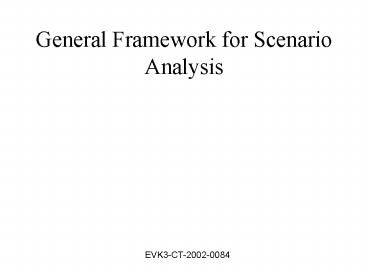General Framework for Scenario Analysis - PowerPoint PPT Presentation
1 / 14
Title:
General Framework for Scenario Analysis
Description:
... equivalent to the implementation of the Water Framework Directive with all its requirements. ... environmental conservation goals in preference to economic ... – PowerPoint PPT presentation
Number of Views:51
Avg rating:3.0/5.0
Title: General Framework for Scenario Analysis
1
General Framework for Scenario Analysis
EVK3-CT-2002-0084
2
INTRODUCTION
Scenario A coherent, internally consistent and
plausible description of a possible future state
of the system under investigation
- Scenario characteristics typology (EEA, 2000)
- Forecasting scenarios study future alternative
development - Backcasting scenarios Describe the desired
future and explore strategies to reach the
desired goals - Descriptive scenarios set out a sequenced set
of possible events in a neutral way - Normative scenarios incorporate different
interests, values and ethics - Quantitative scenarios Computable model-based
exercises - Qualitative scenarios rely solely on narratives
- Trend (Bussines As Usual) scenarios
extrapolation of current trends - Extreme scenarios incorporate unlike and/or
extreme evants and their consequences
3
- GENERAL SCENARIOS
- BUSSINES AS USUAL (BAU), which is based on the
assumption of the continuation of current trends
into future. In this case prevailing trends will
be allowed to continue without major
intervention. - POLICY TARGETS (PT), which is based on the
assumption that in the future all current
regulatory standards and targets will be met.
This is equivalent to the implementation of the
Water Framework Directive with all its
requirements. - DEEP GREEN (DG), which is based on the
assumption that there is a shift in EU society
towards environmental conservation goals in
preference to economic growth-related objectives.
In this case, the goal will be the
re-establishment of pristine conditions subject
to the historical legacies.
From EUROCAT Project
4
THRESHOLDS project
Non-linear cause-effect relationship between
driver and state
Corridors of Sustainability
EUROCAT project
5
DPSIR Framework Analysis for DITTY sites
6
DPSIR Framework Analysis for DITTY sites
Relevant watershed driving forces and impacts
7
DPSIR Framework Analysis for DITTY sites
Relevant lagoon driving forces and impacts
8
Linking Scenario Analysis to Models
9
Scenario Analysis Quantification
- Effects of nutrient loads, Catchment modelling
Joint investigation by modellers and social
scientists to study the feasibility,
effectiveness and practicability of changing
loads and quality improvements, together with
enabling measures and instruments (e.g. improved
sewage treatment altered agricultural practices,
fertiliser taxes, etc.)
10
Scenario Analysis Quantification
- Effects of nutrient loads, coastal lagoon
modelling results
11
Scenario Analysis Quantification
- Bacteria of sanitary concern, Catchment modelling
- Bacteria of sanitary concern, lagoon modelling
Bacteria concentration will serve as a forcing
function in the lagoon model or as a source into
the lagoon.
12
Scenario Analysis Quantification
- Climate Change, Catchment modelling
A climate change scenario assuming the indicated
timeframe in the WFD (2015) will be generated for
each lagoon taking into account long term climate
variation, i.e.increase in air temperature and
precipitation variability, from the IPPC (Europe)
by modifying weather time series. All the other
scenarios will use this synthetic weather time
series (check if SWAT can be do it)
13
PRedICT Description(A GIS-DSS for Watershed
Management,)
- PRedICT (Pollution Reduction Impact Comparison
Tool) was developed as a companion software tool
for use with AVGWLF
http//www.orser.psu.edu/gissupport/predict.htm
14
- PRedICT evaluates the implementation of both
agricultural and non-agricultural pollution
reduction strategies at the watershed level. - This tool allows the user to create various
scenarios for future conditions that reflect
the use of different pollution reduction
strategies such as agricultural and urban best
management practices (BMPs). - PredICT can evaluate the conversion of septic
systems to centralized wastewater treatment, and
upgrading of treatment plants from primary to
secondary to tertiary. - A rather simple cost-accounting approach is used
to estimate load reductions and their associated
costs.































